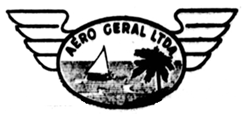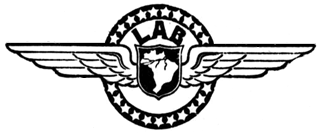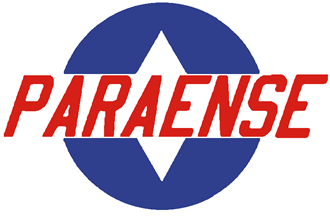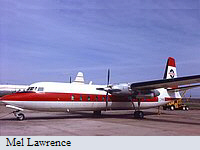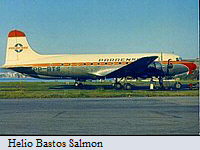|
|
The French airline Latécoère was founded in 1917, by the aircraft
manufacturer of the same name. Latécoère entered the commercial aviation
business after it saw demand for military planes plummet following the
First World War. In 1918 the company began studies to implement its
postal lines to South America. In December 1918 the company launched
flights between Toulouse and Barcelona. In 1919 the route was extended
to Rabat and Casablanca. Only in 1925 did the company extend the route
again, which reached Dakar. So Latécoère was ready to cross the Atlantic.
To be able to fly to Brazil, the company was forced to create a
subsidiary in the country. The first attempts were in January 1925, when
Latécoère brought Breguet 14 aircraft by ship to Rio de Janeiro, which
carried out experimental flights in the country. However, the French
soon had to deal with legal difficulties in creating a company in Brazil.
The Brazilian subsidiary would only be officially created in December
1927, initially called Companhia Brasileira de Empreendimentos
Aeronáuticos (CBEA). In the same year the company's name was changed to
Compagnie Générale Aéropostale (C.G.A.), in the Portuguese version "Cia
Aeropostal". The Brazilian subsidiary carried out its first flights in
November 1927, between Rio de Janeiro and Natal, operated once a week.
At that time, Aéropostale also already had subsidiaries in Argentina and
Uruguay and soon tried to connect Buenos Aires, Montevideo and Rio de
Janeiro.
The first airmail service between France and South America began in
March 1928, on a flight that lasted 7 days! This is because night
flights were not yet available. Even so, it was already a big reduction
compared to the 15 days it took for a letter from Brazil to arrive in
France before aviation. In 1930 the flight time was reduced to "just" 3
days. The Atlantic crossing took around 22 hours and covered the route
between Mermoz/São Luiz (in Senegal) and Natal (in Brazil). Aéropostale
was responsible for the creation of some airports in Brazil, which
served as a base for its flights between France and South America: the
fields of Natal, Recife, Maceió, "Bahia", Caravellas, Vitória, Santos,
Florianópolis, Porto Alegre and Pelotas. To cross the Atlantic Ocean,
Aéropostale used land aircraft, seaplanes and boats (the service only
dispensed with boats and became entirely aerial in January 1936). The
vessels were known as "avisos": with twice the speed of ordinary ships.
The most powerful plane was the Latècoere 28, the fastest commercial
aircraft at the time. The cabin of the Latècoere 28 had eight seats to
transport passengers, if necessary. The majority of Aéropostale's fleet
were aircraft registered in France (with prefix "F"), however the
Brazilian subsidiary had two Latécoère 25 registered in Brazil. The
route between France and the coast of Africa was done with airplanes,
between Mermoz/São Luiz and Cape Verde was done with seaplanes, from
Cape Verde to Fernando de Noronha with boats, from Fernando de Noronha
to Recife with seaplanes and from Recife to Buenos Aires with airplanes.
In 1928 the route between France and South America followed the
itinerary Toulouse - Alicante - Casablanca - Dakar - Natal - Recife -
Maceió - Salvador - Caravellas - Vitória - Rio de Janeiro - Santos -
Florianópolis - Porto Alegre - Pelotas - Montevideo - Buenos Aires.
Another challenge for the company was crossing the Andes mountains,
which many people thought was impossible. The crossing section was
between Mendoza (in Argentina) and Santiago (in Chile). On this route,
planes could not stay below 4,500 meters due to the high altitude of the
mountains. Sometimes it was necessary to climb up to 6 or 7 thousand
meters, where the temperature could reach minus 50ºC. The first flights
to Chile took place in November 1928.
In 1930 Aéropostale launched passenger flights between Rio de Janeiro,
Montevideo and Buenos Aires, with Latècoere 28 aircraft. The journey
between Brazil and Argentina lasted around 12 hours, on the route Rio de
Janeiro - Santos - Porto Alegre - Montevideo - Buenos Aires. Still in
1930 Aéropostale carried out experimental flights between Rio de Janeiro
and Bolivia.
In 1931 Aéropostale lost its subsidies from the French government and
ceased operations in March of the same year.
In 1933 the route was taken over by Air France, which operated to Brazil
until the beginning of the Second World War, when services were
interrupted until the end of the conflict.
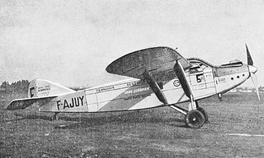
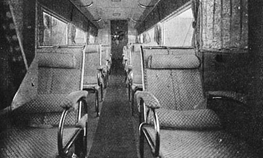
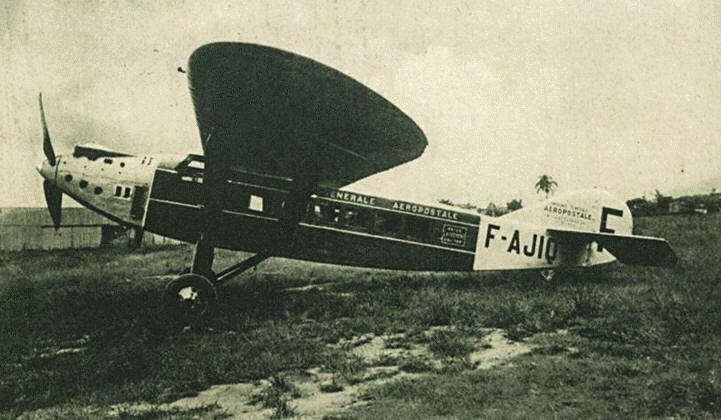
Founded:
1927
Ceased:
1933
Headquarters:
Rio de Janeiro
> Route Map:
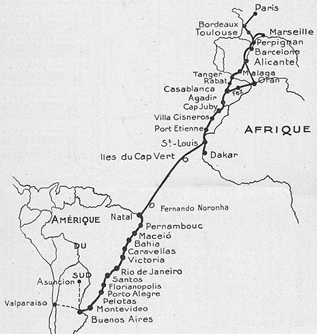
Updated 2023
|
|
Aero Geral was founded in 1941 by Brazilian aviators Custodio Neto
Junior, Carlos Fabricio Rocha, Edgar Mac Laren and Rodolfo Galindo
Borda. The company began carrying out experimental flights in February
1942 with a Monocoupe 90A. However, due to operational problems, the
company was only able to begin official operations in January 1947. To
achieve this, Aero Geral acquired three Catalina, which began operating
on the route Santos - Rio de Janeiro - Vitória - Salvador - Aracaju -
Maceió - Recife - João Pessoa - Natal. Initially the route was operated
twice a week, with departures from Rio de Janeiro to Santos on Thursdays
and to Natal on Fridays.
Aero Geral chose Natal as its maintenance base due to its strategic
location, with a good port for landing seaplanes (at the time) and
proximity to the USA and Europe. Unlike other Brazilian airlines, Aero
Geral focused on attracting passengers with lower fares. This was
possible thanks to the absence of "luxury" commonly offered to
passengers in the 1940s and 1950s. In 1948, Aero Geral carried out 221
flights, transported 7925 passengers and 330 tons of cargo.
In 1950 the company's fleet increased with the acquisition of a Curtiss
C-46 and two Douglas DC-3. The flights between Rio de Janeiro and Natal
began to be operated by DC-3 on Mondays, Thursdays and Saturdays and by
Catalina on Tuesdays and Fridays. With the new land aircraft, flights
also became faster, the journey between Rio de Janeiro and Natal was
covered in "just" 11 hours.
In 1952 Aero Geral was acquired by Varig, which took over its routes and
was able to expand its network to the northeast region of Brazil.
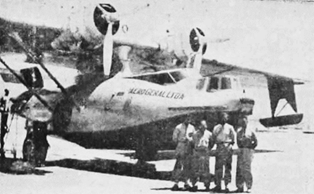
Diário da Manhã (PE) 1947
Founded:
1941
Ceased:
1952
Headquarters:
Rio de Janeiro
Historical
Fleet:
4xConsolidated Catalina, 1xCurtiss C-46, 2xDouglas DC-3
> Route Map:
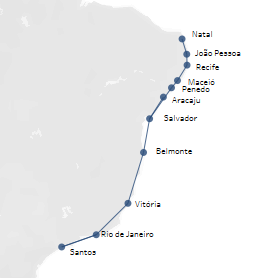
Updated 2023
Aerolloyd Iguassú was founded in 1933 by the company Leão Junior & Cia (Matte
Leão). The initial fleet was two Klemm 31s, with capacity for 3
passengers and a speed of 170 km/h. The aircraft were presented in May
at Campo de Marte airport, in São Paulo. To fly the aircraft, the
company hired German pilot Fritz Buehler. The first route, between
Curitiba and São Paulo, was opened in July 1933, with a frequency of
four times a week.
In February 1934 the route was extended to Joinville, Itajaí and
Blumenau, and the following year to Florianópolis. The company also
acquired two Stinson Reliant aircraft. In 1934 Aerolloyd transported
around nine hundred passengers. The following year the number of
passengers transported increased to more than a thousand and the company
acquired its third Stinson Reliant.
Aerolloyd's expansion plans included new regional flights in Paraná and
Santa Catarina, including Foz do Iguaçu, and international flights to
Asunción and Montevideo. The company saw international flights as a
salvation for the loss-making domestic flights that were taking
Aerolloyd into an increasingly complicated financial situation. In
January 1936 the company began to suspend flights and stopped all
operations in June. In December Aerolloyd resumed flights connecting São
Paulo, Curitiba and Florianópolis.
In 1937 Aerolloyd expanded its network to Rio de Janeiro and Belo
Horizonte, in partnership with Vasp. However, the company's financial
difficulties continued.
In October 1939 Aerolloyd Iguassú was sold to Vasp.
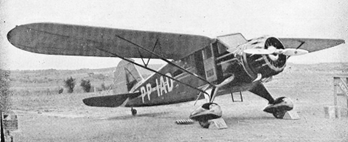
Founded:
1933
Ceased:
1939
Headquarters:
Curitiba
Historical
Fleet:
2xKlemm 31, 3xStinson Reliant
Destinations: São Paulo, Rio de Janeiro, Belo Horizonte, Curitiba, Itajaí, Blumenau,
Brusque, Joinville e Florianópolis
Updated 2023
|
|
Companhia Itaú de Transportes Aéreos was founded in 1947, as a
subsidiary of Companhia de Cimento Itaú, being the first exclusively
cargo airline in Brazil. The company began operating in July 1948 with a
fleet of nine Curtiss C-46s, connecting São Paulo, Rio de Janeiro, Belo
Horizonte, Salvador, Recife, Fortaleza and Campo Grande. In April 1950
Itaú announced the purchase of four additional C-46s. However, a series
of accidents caused fleet reduction.
In 1951 the network was expanded to Curitiba, Porto Alegre. Penápolis
and Corumbá.
In October 1955 the company was acquired by Transportes Aéreos Nacional.
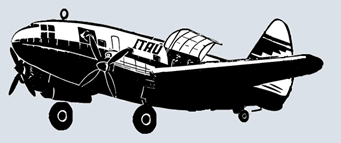
Founded:
1947
Ceased:
1955
Headquarters:
Rio de Janeiro
Historical
Fleet:
11xCurtiss C-46
Updated 2023
|
|
Linhas Aéreas Brasileiras S.A. (LAB) was officially founded on July 14,
1945, in Belém, by José Sampaio Freire. The project to create the
company had been developed since 1943 and to capitalize on the company,
a popular subscription was launched. The original plan called for an
operations base in Belém, which would connect the North, Northeast and
Southeast regions, with passenger and cargo flights. However, the
company changed its strategy, starting to operate from the southeast and
expanding the network to the north, with the intention of reaching
Belém. To start operations, LAB ordered six DC-3s directly from Douglas,
for 22 , 24, 25 or 26 passengers. In November 1945 the first plane
arrived in Rio de Janeiro.
LAB's first flight was carried out on December 1, 1945, with the
transport of 60 tons of cargo between Rio de Janeiro, Salvador and
Recife. Regular passenger flights only opened on February 11, 1946, on
the Rio de Janeiro - São Paulo route. Flights between the two cities
were daily and departed from Rio at 9 am and 1:30 pm and from São Paulo
at 11 am and 3:30 pm. At that time, LAB already had five DC-3s in its
fleet. On February 27th, the Rio de Janeiro - Belo Horizonte route was
inaugurated. The following day the route to São Paulo was extended to
Uberaba and Uberlândia. In April, L.A.B. was authorized to operate on
the Rio de Janeiro - Vitória - Ilhéus - Salvador route. Later the route
was extended to Aracajú, Maceió, Recife, João Pessoa, Campina Grande and
Natal. On June 7th the route to São Paulo was extended once again,
arriving in Ituiutaba.
In 1947 LAB was already experiencing financial difficulties. In 1948
several problems began to arise, such as labor lawsuits and flight
irregularities, culminating in the end of its activities. Only in the
month of June 1948, LAB was fined sixteen times by the Civil Aeronautics
for failing to carry out regular flights on the route between Rio and
São Paulo and Rio and Salvador, in addition to a delay of more than 24
hours on two flights between Rio and Salvador. In October of the same
year, the company filed for bankruptcy. LAB's bankruptcy was declared on
March 9, 1949.
On May 17, 1949 one of its DC-3s, PP-BRB, was auctioned at Santos Dumont
airport to cover part of the company's debts.

Founded:
1945
Ceased:
1948
Headquarters:
Rio de Janeiro
Historical
Fleet:
6xDouglas DC-3
> Route Map:
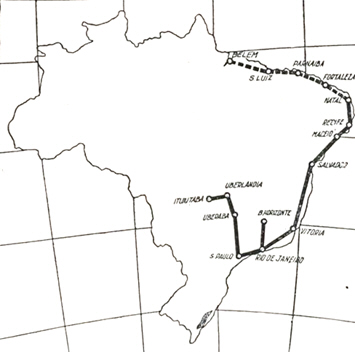
1946
Updated 2023
|
|
Linhas Aéreas Paulistas S.A. (LAP) was founded in 1943, with its main
organizers being Floriano Nunes Pereira, Almerindo Marques and Julio
Paim. The company's initial plan included flights in São Paulo, Minas
Gerais, Paraná, Mato Grosso, Goiás and the São Paulo - Natal line, with
expansion to Lisbon, in Portugal. The company's capitalization was
carried out by popular subscription, which began in November 1943, being
the first to be organized in accordance with the new Law of "Sociedades
por Ações". In January 1945 LAP had already reached 16 thousand share
subscribers, most of them from Rio de Janeiro.
The first aircraft was a Lockheed Hudson, for cargo transport, received
in June 1945. In December of the same year, the aircraft carried out
experimental flights on the route Rio de Janeiro - Curitiba -
Florianópolis - Rio de Janeiro. In June 1946 LAP received two DC-3s with
capacity for 24 passengers. In September of the same year, experimental
flights were made on the Rio de Janeiro - São Paulo - Curitiba - Porto
Alegre route.
Regular operations began in December 1946, connecting São Paulo to
Recife with several stops along the Brazilian coast, operated three
times a week. The flights took off from Rio at 5:05 am and landed in
Recife at 5:00 pm on the same day and were operated with up to four
Douglas DC-3s.
In August 1948 the company expanded the network to Campina Grande and
Natal. The fleet grew with the third DC-3, in June 1947, and the fourth
in December 1948. In 1948, LAP transported 17 thousand passengers and
526 tons of cargo (compared to 9 thousand passengers and 304 tons in
1947) and employed 117 staff.
In September 1949 the company received more two DC-3s. The company's
intention was to reach Lisbon, crossing the Atlantic Ocean between Natal
and the capital of Portugal, but LAP never operated international
flights. In 1949 the company was already showing signs of financial
difficulties. In October one of its aircraft, PP-LPE, was seized to pay
debts.
In 1950 LAP began operating in a consortium with Loid Aéreo Nacional,
being completely absorbed by it the following year.
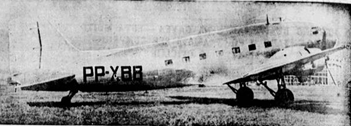
Founded:
1943
Ceased:
1951
Headquarters:
São Paulo
Historical
Fleet:
6xDouglas DC-3, 1xCurtiss C-46,
1xLockheed Hudson
> Route Map:
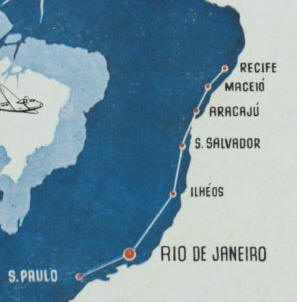
1946
Updated 2023
Founded in February 1952, Paraense Comercial Ltda. began operations with
a Consolidated PBY-5A Catalina seaplane and exclusively transported meat
between Belém and Goiânia. Later it changed its name to Paraense
Transportes Aéreos S.A. (PTA).
In 1957 it received two Curtiss C-46s and began transporting passengers.
The first passenger line was opened in November: Belém - Brasília - Rio
de Janeiro.
In 1961 the company already covered half of the country, with the routes
Belém - São Luis - Fortaleza, Belém - Pedro Afonso - Cristalândia -
Brasília - Rio de Janeiro, Belém - Pedro Afonso - Goiânia - São Paulo
and São Paulo - Campo Grande - Cuiabá - Porto Velho - Rio Branco.
In 1962 the fleet reached 10 units, with the receipt of more two DC-4s
in June. In the same year, PTA arrived in Manaus with the DC-4.
In 1966 Paraense placed a C-46 based in Manaus, which allowed the
company to expand its network on the route Manaus - Porto Velho - Rio
Branco - Porto Velho - Cuiabá - São Paulo. Furthermore, in January, it
opened new routes to Altamira, Santarém, Jacareacanga, Parnaíba and
Recife.
The company acquired Fairchild Hiller FH-227 aircraft, also known as "Hirondelle",
in October 1967. However, aircraft maintenance was not the company's
strong point. Two of the company's DC-4s crashed after just two years of
operation. In addition, eight C-46s crashed in about a decade. So many
accidents ended up leading to the cancellation of its operations
certificate in May 1970. Its aircraft were transferred to Varig.
Founded:
1952
Ceased:
1970
Headquarters:
Belém
Historical
Fleet:
3xPBY-5A Catalina, 21xCurtiss C-46 Commando,
2xDouglas DC-3, 5xDouglas DC-4,
6xFairchild Hiller FH-227B
> Route Map:
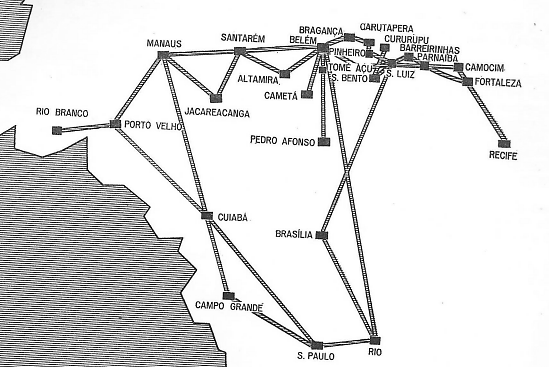
1967
Updated 2023
|
|
The Sociedade Anônima Viação Aérea Gaúcha (SAVAG) was founded in
November 1946 and soon gained support from Panair and Cruzeiro, who
wanted to stop Varig's growth. The first aircraft came from Panair,
three Lockheed Lodestar. The first route was the same Varig's inaugural
route, connecting Porto Alegre to Rio Grande and Pelotas. However, in
January 1949 the company lost one of its aircraft in an accident. In
June 1950 another Lodestar crashed, leaving SAVAG fleet with just one
aircraft. The help came from Cruzeiro, which transferred two DC-3s to
the company. The first was received in 1951 and the second in 1957. The
company's network was expanded to cities such as Alegrete, Bagé,
Cascavel, Passo Fundo, Toledo, Uruguaiana and Santana do Livramento.
Cruzeiro increasingly controlled the company, providing crew and
operational support.
However, competition with Varig and the increase of other transport
options such as new highways and railways, made the flights occupancy
increasingly smaller in the 1960s. Cruzeiro began to cut loss-making
routes and SAVAG began to operate between Porto Alegre and Curitiba. But
that was not enough to reverse the loss. At the end of 1965, Cruzeiro
resumed its two DC-3s and SAVAG ceased all activities in January 1966.
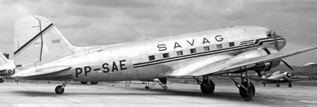
Founded:
1946
Ceased:
1966
Headquarters:
Porto Alegre
Historical
Fleet:
3xLockheed Lodestar,
2xDouglas DC-3
> Mapa de Rotas:
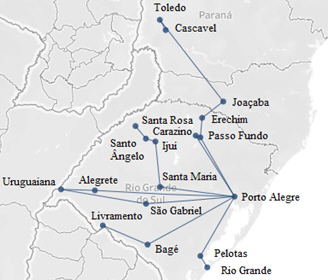
Updated 2023


